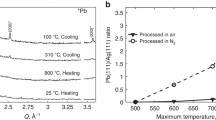Abstract
In the present study, the chemical interaction between screen-printed solar cell front-side contacts and electrolyte solutions is investigated in detail. Especially the Ni-plating process is known to lower the mechanical adhesion of solar cell contacts significantly. The mechanisms behind this adhesion loss were analyzed by performing contact exposure experiments with and without applied voltage in electrolyte solutions with subsequent characterization of the contact peel-force, complemented with X-ray-diffraction investigations of the material changes in the solid contact compounds. Reaction paths, behind the contact corrosion, as observed in SEM images, were identified: PbO and Ag2O out of the contact react with sulphates and chlorides in the electrolyte, forming lead sulphate and silver chloride. If a voltage is applied to the contacts an alternative more effective reaction path were identified. The voltage offers the possibility to reduce the dissolved lead and silver, and this shifts the equilibrium reactions strongly towards further dissolution. The activity of the reduction was found to depend on the reduction potential of the cations in the used electrolyte solution. The less noble the metal to be deposited on the solar cell contacts, the more difficult it is to achieve the deposition without adhesion loss of the screen-printed solar cell contact.









Similar content being viewed by others
References
Bartsch J, Mondon A, Kamp M, Kraft A, et al. (2012) Progress with multi-step metallization process featuring copper as conducting layer at Fraunhofer ISE. In: Proceedings of 27th EU PVSEC, Frankfurt, Germany, pp 604–607
Kraft A et.al. (2014) Long-term stability analysis of copper front side metallization for silicon solar cells. In: Proceedings of 4th Silicon PV, ´s-Hertogenbosch, the Netherlands
DIN EN 50461:2006, Solar Zellen and IEC 61189-2:2006 Prüfverfahren für Elektromaterialien, Leiterplatten und andere Verbindungsstrukturen und Baugruppen
Kraft A et al (2014) Microstructure analysis of the interaction between Watts-type nickel electrolyte and screen printed solar cell contacts. ECS J Solid State Sci Technol 3:55–60
Wendling MD, Mondon A et.al. (2012) Analysis of chemical stability of printing pastes in electrochemical plating solutions. In: Proceedings of 2nd Silicon PV, Leuven, Belgium, pp 497–502
Unruh JN (2001) Tabellenbuch der Galvanotechnik, Eugen G. Leuze Verlag,7. Auflage, Bad Saulgau
Hörteis M (2010) Fine-line printed contacts on crystalline silicon solar cells. Ph.D. thesis, Universität Konstanz
Schubert G (2008) Thick film metallization of crystalline silicon solar cells. Ph.D. thesis, Albert-Ludwigs Universität, Freiburg im Breisgau
Nagesh VK et al (1983) Wetting and reactions in the lead borosilicate glass-precious metal systems. J Mater Sci 18:2173–2180
Thompson WT et al (2000) Pourbaix diagrams for multielement systems. In: Grambow B, Revie R (eds) Uhlig´s corrosion handbook, chapter 7, 2nd edn. Wiley, New York
Acknowledgments
This work was supported by the German Federal Ministry of Economic Affairs and Energy (BMWi) under the contract number 0325456 (KuLi).
Author information
Authors and Affiliations
Corresponding author
Rights and permissions
About this article
Cite this article
Kraft, A., Pernia, Y., Kalio, A. et al. Origin of corrosion effects in solar cell contacts during electrochemical nickel deposition. J Appl Electrochem 45, 95–104 (2015). https://doi.org/10.1007/s10800-014-0770-3
Received:
Accepted:
Published:
Issue Date:
DOI: https://doi.org/10.1007/s10800-014-0770-3




